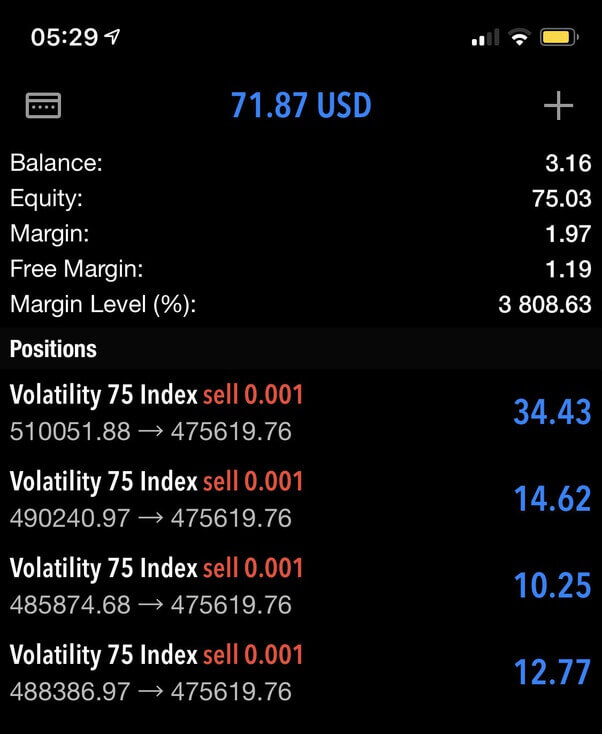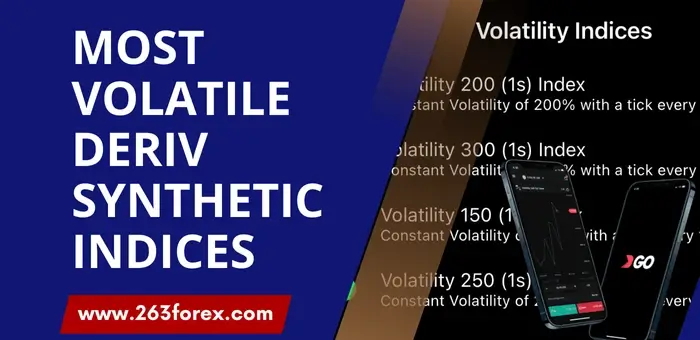If you’re into fast-moving markets and high-risk, high-reward setups, Deriv’s synthetic indices offer some of the most volatile instruments out there. The fact that they are available for trading 24/7 adds to the excitement.
What Is Volatility in Synthetic Indices?
Volatility simply means how much price moves, and how fast.
In high-volatility indices like V75 or V300 (1s), price can shoot up or drop sharply within seconds. These sharp movements create more trading opportunities — but also come with bigger risks if you’re on the wrong side of the move.
Deriv’s synthetic indices are built with fixed volatility levels. That means you can actually choose how fast or slow a market moves by picking the right index.
Not every index is built for speed. Some move slower and are better for beginners or longer-term trades.
👉 Want the calm side of the market? Read: Least Volatile Synthetic Indices on Deriv →
Now let’s move to the actual indices that are fast-moving.
Based on my experience and what’s popular among traders, here’s a ranked list of the top five:
1. Volatility 300 (1s) Index
- Volatility Level: Extremely high
- Tick Frequency: Every second
- Trading Style: Suitable for experienced scalpers
This index is not for the faint-hearted. It moves rapidly, offering significant opportunities for those who can manage the risk.
2. Volatility 100 Index
- Volatility Level: Very high
- Tick Frequency: Every two seconds
- Trading Style: Ideal for momentum traders
Known for its aggressive price swings, this index is popular among traders looking for substantial movements.
3. Volatility 75 Index
- Volatility Level: High
- Tick Frequency: Every two seconds
- Trading Style: Great for trend followers
Often referred to as the “King of Synthetic Indices,” it offers a balance between volatility and predictability.
This is my personal favourite since 2016. I have traded it extensively. Below is a screenshot of some of the trades I took on the index.

— Jafa Omar
4. Volatility 50 (1s) Index
Volatility Level: Moderate to high
- Tick Frequency: Every second
- Trading Style: Suitable for both scalpers and swing tradersSynthetics.Info+1Deriv+1
This index provides a middle ground, with enough movement to be exciting but not as erratic as the higher-ranked indices.
5. Volatility 25 (1s) Index
- Volatility Level: Moderate
- Tick Frequency: Every second
- Trading Style: Ideal for those new to volatile markets
A good starting point for traders looking to get into more volatile instruments without diving into the deep end.

🛡️ How to Manage Risk When Trading Volatile Synthetic Indices
Trading highly volatile synthetic indices like V75, V100, or V300 (1s) can be rewarding, but they require disciplined risk management. Here’s how to approach them safely:
📊 Minimum Lot Sizes for Volatile Indices
Each synthetic index has its own minimum lot size. Here’s a quick reference:
| Index | Minimum Lot Size |
|---|---|
| Volatility 75 Index | 0.001 |
| Volatility 75 (1s) Index | 0.05 |
| Volatility 100 Index | 0.5 |
| Volatility 100 (1s) Index | 0.2 |
| Volatility 300 (1s) Index | 1.0 |
💰 Recommended Account Sizes For Trading Volatile Indices
To manage risk effectively, consider these minimum account balances:
| Index | Recommended Account Size |
|---|---|
| Volatility 75 Index | $50+ |
| Volatility 75 (1s) Index | $100+ |
| Volatility 100 Index | $200+ |
| Volatility 100 (1s) Index | $300+ |
| Volatility 300 (1s) Index | $500+ |
These recommendations aim to keep your risk per trade within 1-2% of your account balance.
However, you can trade with lower balances but this will significantly increase your chances of blowing.
In the screenshot I sent, I started with $3 and grew to $75. This was purely a risky experiment, and I was ready to lose that balance at any time.
Do not use that as a benchmark, it’s a very wild outlier.

📈 Maximum Number of Open Positions
Limiting the number of open positions helps manage exposure:
- Volatility 75 Index: 1-2 positions
- Volatility 75 (1s) Index: 1 position
- Volatility 100 Index: 1 position
- Volatility 100 (1s) Index: 1 position
- Volatility 300 (1s) Index: 1 position
Note: Some traders set personal limits on the number of open positions to manage risk effectively
Again, in my screenshot, I had opened multiple positions on a very small balance. I did this as the initial position went into profits and the trend looked solidified.
This gave me a chance to pyramid (add more positions while keeping the same risk). Again, it’s very risky and don’t use it as a benchmark.
The best way to find what works for you is to first demo trade your strategy on your preferred asset.
However, it’s very important to reduce the balance in your demo account to match the deposit you are going to use in real trading. This will ensure that you don’t fool yourself and you have a realistic appreciation of your strategy.
For a more detailed guide on lot sizes and account management, check out our full post: Lot Sizes for Synthetic Indices on Deriv.
Other Tips For Trading Volatile Synthetic Indices
- Always start with the smallest lot size on demo so you can see how the index moves
- It’s best to concentrate on one index at a time. Dividing your attention will hurt your performance.
- Avoid overtrading. Use the correct number of positions and don’t be lured to trade 24/7 just because the index is open.

✍️ Final Thoughts
If you’re drawn to fast-paced markets with big movement potential, these synthetic indices deliver — but only if you respect the volatility.
I’ve blown accounts in the past by rushing in with too many trades or oversized lots. That’s why I always say: start small, time your entries, and let the setup come to you.
You don’t need to trade all five. Pick one that matches your style, learn its rhythm, and build from there.
I hope this guide gives you a clear starting point.
Let me know which one you’re trading — or struggling with — and I’ll try share what’s worked for me. Share your feedback in the comments below.
🔗 More on Synthetic Indices
- 📘 New to synthetic trading? Start with the full beginner guide:
How to Trade Synthetic Indices on Deriv → - 🧊 Prefer calmer markets? Check out:
Least Volatile Synthetic Indices on Deriv → - 🧾Got no account? Open one with step-by-step instructions on the link below:
Deriv Synthetic Account Opening Guide →

FAQ’s On Most Volatile Sythetic Indices
Volatility 300 (1s) is currently the most volatile synthetic index on Deriv. It moves fast and aggressively, making it ideal for experienced scalpers who understand risk.
Yes — V75 remains one of the most traded synthetic indices. It has strong volatility, clean trends, and works well for price action setups if you manage your lot size.
Start with the minimum lot size for each index — for V75, that’s 0.001. You can scale up as your account grows and your strategy improves.
For volatile indices, 1–2 open trades is usually enough. Too many positions increase your risk and make it harder to manage trades during spikes.
You can — but start on demo first. If your capital is under $100, stick to the calmer end (like V25 1s) and always use stops. Volatile markets will punish hesitation or greed.




Other Posts You May Be Interested In
Range Break Indices: A Complete Beginners Guide (2025) 📈
📅 Last updated: May 11, 2025 ✍️ Written by: Jafar Omar ✅ Fact-checked by: Munyaradzi [...]
How To Open Deriv Demo Account MT5 (2025) ✔
📅 Last updated: May 18, 2025 ✍️ Written by: Jafar Omar ✅ Fact-checked by: Munyaradzi [...]
💸 How to Deposit and Withdraw from Your Deriv Account (Updated 2025)
📅 Last updated: May 19, 2025 ✍️ Written by: Jafar Omar ✅ Fact-checked by: Munyaradzi [...]
Boom and Crash Indices on Deriv: Full Beginner Guide (Updated 2025) 📉📈
📅 Last updated: May 7, 2025 ✍️ Written by: Jafar Omar ✅ Fact-checked by: Munyaradzi [...]
Deriv Synthetic Indices Lot Sizes Guide (V75, Boom & Crash, Step Index)
📅 Last updated: May 14, 2025 ✍️ Written by: Jafar Omar ✅ Fact-checked by: Munyaradzi [...]
Deriv Copy Trading Review (2025): Is cTrader Worth It? ♻️
📅 Last updated: May 20, 2025 ✍️ Written by: Jafar Omar ✅ Fact-checked by: Munyaradzi [...]